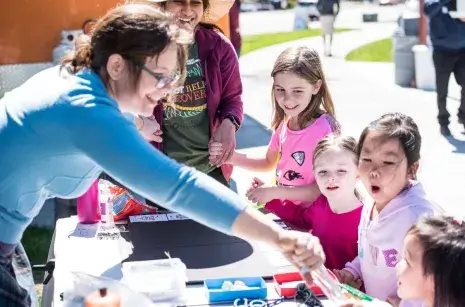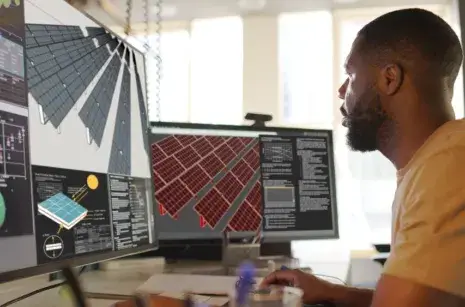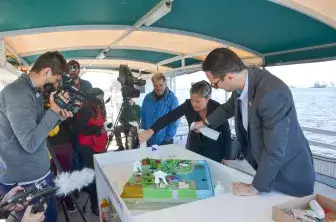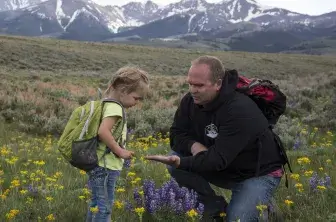Strategy 2: Engage and Educate
Expand Education
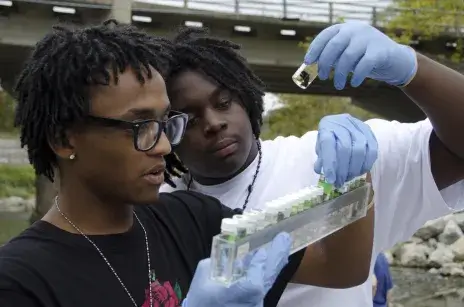
Education, in the classroom and beyond, should lay the foundation for informed and engaged climate participation. Expanding overall access to climate content will help address existing knowledge gaps. However, educators must also be willing to experiment with new kinds of learning, such as role-playing games or local environmental projects.
Advocate for adopting climate standards during state education standards reviews to create lesson plans that incorporate climate learning across subjects.
Create and validate a national assessment instrument to measure climate change knowledge in K–12 and university students.
Fund experiments to design and test new methods for integrating climate across curricula.
More recommendations
The country’s increased engagement on climate change will be easier to sustain over the long term if more Americans have access to climate change education. To that end, sustained climate engagement requires education at the K–12 through university levels, and informally through community outreach, adult education, broadcast science series, museums, and science fairs. Climate science should be incorporated into state curricula and assessments and rooted in known techniques for instruction.[i]
Advocate for adopting climate standards during state education standards reviews to create lesson plans that incorporate climate learning across subjects.
In the United States, the quality of K–12 climate change education varies from state to state.[ii] Some states, such as Wyoming, clearly teach anthropogenic climate change across all grades, while others, such as Pennsylvania, do not mention climate change in their standards. However, even in comprehensive frameworks, most climate discussion centers on traditional frames, such as conservation or fossil fuel reduction, instead of adaptation, Indigenous Knowledge, and environmental justice. Further, less than 50 percent of social studies and 5 percent of language arts standards discuss climate change.[iii] Adequately preparing students for the challenges ahead requires an integrative approach that links climate change with civic engagement, media literacy, and justice. States revise their standards every five to twenty years, typically seeking comments from the public and education experts. Parents, who overwhelmingly support teaching climate change in schools, should continue to advocate for revisions that increase climate content in state standards.[iv]
Create and validate a national assessment instrument to measure climate change knowledge in K–12 and university students.
Improving climate education requires assessing and targeting current gaps in student knowledge. However, while there are instruments to assess student attitudes and beliefs about climate change, there are no standard instruments to measure knowledge, as exist for many other complex and controversial science topics (such as evolution, genetics, and vaccines).[v] Developing and validating this instrument would improve national monitoring of climate knowledge growth and refine educational approaches to address remaining gaps. Education researchers should make the development of this tool a priority. Educators should use these results to develop curricula that address knowledge gaps and help integrate climate concepts outside the science classroom. Key topics include balancing risks and benefits, political decision-making, and the consequences of inequality.
Fund experiments to design and test new methods for integrating climate across curricula.
Participatory experiences like place-based learning and activities that focus on collective causes and action are effective strategies for climate education. Role-playing games, such as the World Climate Simulation, are particularly effective for strengthening applied climate knowledge.[vi] School-based projects, such as environmental advocacy or climate action plans, further help get students involved in climate action. While many curricula use these strategies, they often require significant funding and climate knowledge to teach, which amplify existing inequities in education.[vii] Therefore, an investment must come from the district or state rather than individually motivated teachers.
This experimental approach requires testing new curricula and evaluating which approaches are effective.[viii] Philanthropy, school boards, and state educational institutions should provide funding for education researchers to test curricular efficacy.
[i] Martha C. Monroe, Richard R. Plate, Annie Oxarart, et al., “Identifying Effective Climate Change Education Strategies: A Systematic Review of the Research,” Environmental Education Research 25 (6) (2019): 791–812.
[ii] National Center for Science Education and the Texas Freedom Network Education Fund, “Making the Grade? How State Public School Science Standards Address Climate Change,” October 2020, https://climategrades.org/#data.
[iii] North American Association for Environmental Education and EDGE Research, “The State of Climate Change Education: Findings from a National Survey of Educators” (Washington, D.C.: North American Association for Environmental Education, 2022), https://naaee.org/sites/default/files/2023-02/NAAEE_State%20of%20Climate%20Change%20Education%20Report_SUBMITTED%2012_12_22%5B1%5D.pdf.
[iv] Anya Kamenetz, “Most Teachers Don’t Teach Climate Change; 4 in 5 Parents Wish They Did,” NPR, April 22, 2019, https://www.npr.org/2019/04/22/714262267/most-teachers-dont-teach-climate-change-4-in-5-parents-wish-they-did.
[v] Ross H. Nehm and Louise S. Mead, “Evolution Assessment: Introduction to the Special Issue,” Evolution: Education and Outreach 12 (1) (2019): 1–5; and Michelle K. Smith, William B. Wood, and Jennifer K. Knight, “The Genetics Concept Assessment: A New Concept Inventory for Gauging Student Understanding of Genetics,” CBE—Life Sciences Education 7 (4) (2008): 422–430.
[vi] Juliette N. Rooney-Varga, John D. Sterman, Eduardo Pedro Fracassi, et al. “Combining Role-Play with Interactive Simulation to Motivate Informed Climate Action: Evidence from the World Climate Simulation,” PLOS ONE 13 (8) (2018), https://doi.org/10.1371/journal.pone.0202877.
[vii] U.S. Environmental Protection Agency, “Climate Change Resources for Educators and Students,” last updated May 16, 2023, https://www.epa.gov/climate-change/climate-change-resources-educators-and-students; and Ann Hindley, “Understanding the Gap between University Ambitions to Teach and Deliver Climate Change Education,” Sustainability 14 (21) (2022): 13823.
[viii] David Rousell and Amy Cutter-Mackenzie-Knowles, “A Systematic Review of Climate Change Education: Giving Children and Young People a ‘Voice’ and a ‘Hand’ in Redressing Climate Change,” Children’s Geographies 18 (2) (2020): 191–208.


